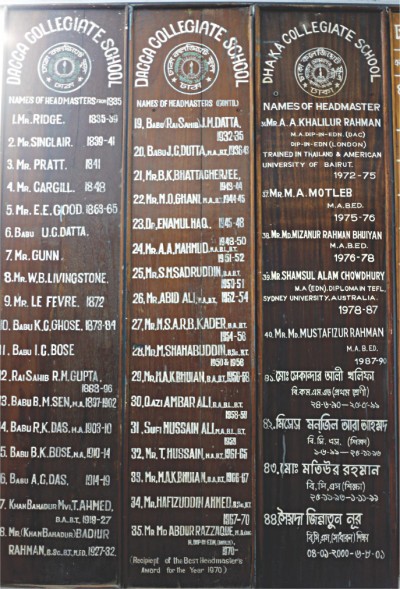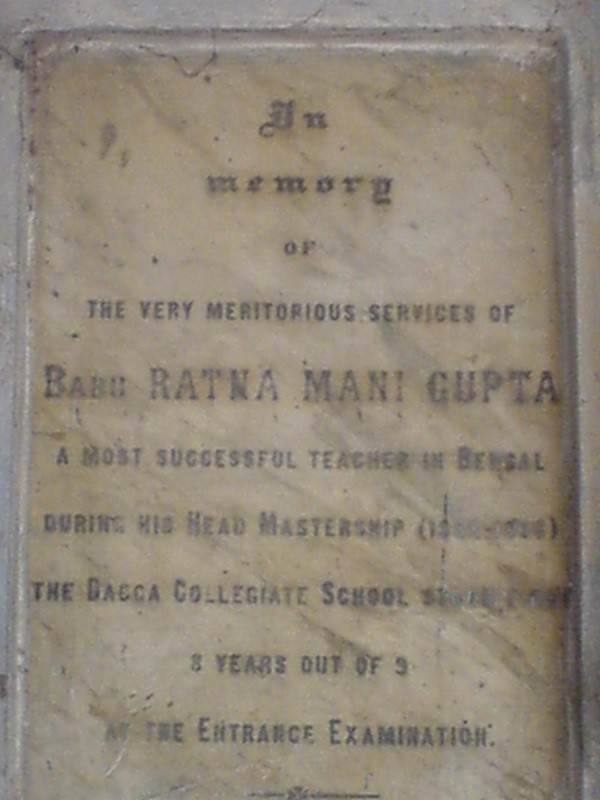Maria Mohsin
Dhaka Collegiate School is the first government high school in undivided Bengal. In 1835, the General Committee of Public Instruction submitted a proposal to Lord William Bentinck, the then governor-general of India, to establish an institution that would teach English literature and science. As a result of that proposal, Dhaka Collegiate School was established in 1835 as an English seminary by the British government, and an English missionary named Ridge was appointed as its first headmaster. The 187-year-old boys’ school was first located a couple of blocks away from its present location at Loyal Street, Sadarghat. A British colonial bungalow was first used for the Dhaka Collegiate School, and later, it was moved to a new building, which was built at the site of an indigo factory.
Dhaka Intermediate College, now renamed as Dhaka College, was established in the premises of the Collegiate School in 1841 and housed on the first floor, while the school remained on the ground floor. Dhaka College was first relocated to a larger building near Victoria Park, now Bahadur Shah Park, in 1873, and was moved a few other times till it was finally got its own campus on Mirpur Road near New Market in the 1950s.


The Collegiate School started off with just three teachers and 136 students in 1935. It was given the status of a zila (district) school in 1908. The school also included a hostel for students, named ‘Raj Chandra Hindu Hostel’, which is no longer in use.
Famous Students
Dhaka Collegiate school’s famous old students include freedom fighter Bir Shreshtho Matiur Rahman, scientist Jagadish Chandra Bose, Nawab of Dhaka Khwaja Abdul Ghani, and the founder of Pogose School, Nicholas Pogose.
Dhaka Collegiate School , now
Dhaka Collegiate School now has 2,200 students, who study in classes 2 to 10 in two shifts. “Besides education, the school encourages students to take part in extracurricular activities, and that is why we have a science club, agriculture club, debating club, language club, Boy Scouts and Red Crescent Youth units, and more. We also organise national anthem competitions among different classes,” Mohammad Abu Sayeed Bhuiyan, the present headmaster, told Y&I.
The school now has two buildings, the old yellow two-storey schoolhouse with wooden shutters is still there, while a modern multi-storey red brick building, with grilled windows, stands next to it. The school demonstrates a proper contrast of then and now Dhaka _ even today, there are desks and chairs from the 1800s, some of which are still used by the students.

“The old school building from the 19th Century is still there, but abandoned as it is not in a condition for use. But it has not been torn down as old and new students of the school want us to keep it as a symbol of the school’s long history,” Bhuiyan said.
“There was a time when this school was the most famous school in the city, and it has a glorious history, too. But now it is losing its glory as people prefer other famous schools in new Dhaka,” the headmaster added. “Though we try to maintain high standards in our school, we see that the guardians are not bothered enough about education. About 80 percent of the parents of our students are businessmen and homemakers, and most of them want their children to run the family business. So, education for them is just a token, not a necessity, and that’s responsible for declining standards now. But still, we maintain 100 percent pass rate in SSC (secondary school certificate exams).”
Dhaka Collegiate School Students Reminisce
Abu Selim, a businessman and a former student of the school, told this reporter: “I got graduated from Dhaka Collegiate School in 1995 and I feel so proud of being a part of that institute, which is 183 years now. It has produced so many leading figures for the county. Now, my son goes to the same school, and I proudly share memories of my schooldays with him. But now, the condition of the school is deteriorating due to lack of attention from the authorities.”
Mohannad Abdul Kawser, another ex-student who is now a banker, added: “I left the school almost 10 years ago. It always fascinates me how this institution is still standing with such a long history. And how many students have passed through the corridors of this school. But the school has not developed even a bit since I left it. On the contrary, it is going under and it feels very bad to see my school like that. We have to keep in mind it is not just an institute, it’s an institution which has been carrying our country’s history for almost 200 years.”
“We do have some internal issues, which we need to resolve. It’s a government school, but we haven’t received even a single bench from the authorities in the past 10 years. We get donations from old students sometimes, and that’s how we work,” Bhuiyan, the headmaster, explained. “There are other problems, too. For example, there is a bus and tempo stand in front of the school which not safe for our students. But no action has been taken to move it, even after complaining repeatedly. So, it is not only up to the students or the teachers, the government needs to pay attention to bring back the old glory of the school,” he added.
The article was first published in The Independent on September 6, 2018.
